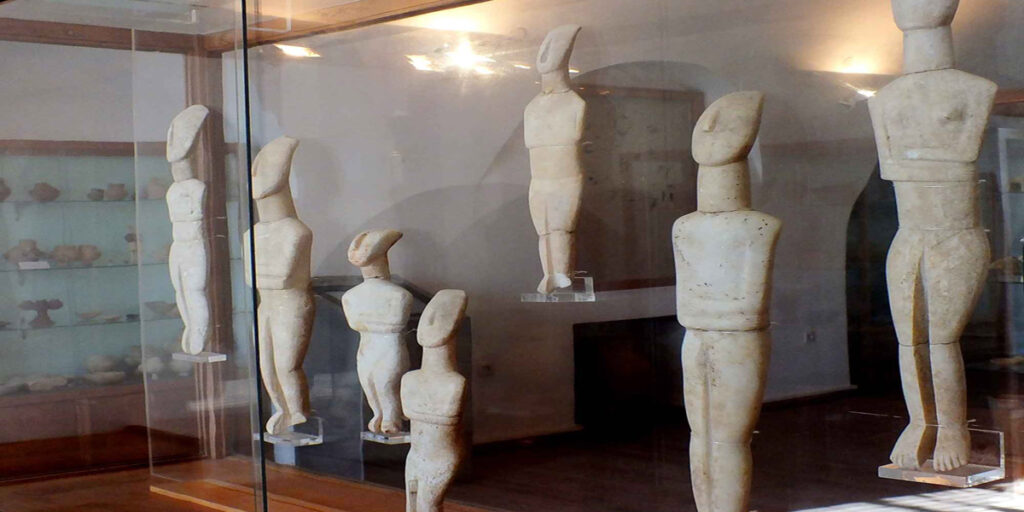Tourist attractions

Museums of Naxos
- The Archaeological Museum of Naxos. It is located in the Upper Town. The Historical Archive of Naxos is housed today in the former French School, which is located inside the Castle of Naxos and which was remodeled especially for this purpose. Nikos Kazantzakis also studied at this School.
- This really interesting museum exposes a collection of objects and art works dating from the late Neolithic period until the early Christian times.
- The Archaeological Museum of Epiranthos.
- The Natural History Museum of Epiranthos.
- The Geological Museum of Epiranthos is perhaps one of the largest of its kind in Greece with many rocks from the region and from all over the world.
- The Folklore Museum of Epiranthos is housed in a traditional village house and has all the household, agricultural and livestock objects of the 19th century.
- The Museum of Visual Arts of Epiranthos is a Contemporary Art Gallery with more than 70 works.
- The Nikos Nikolaos Glezos Library with 20,000 volumes of books in Apeiranthos
Archaeological sites and monuments
- Portara: The ruins of the archaic temple of Apollo whose huge gate, called "Portara" on the islet "Palatia", and the marble bases - frame of the Temple are preserved. Since 1919 it has been connected to the island just north of the port of Naxos.
- Ancient Naxos: The ruins of a Mycenaean settlement at the "Grota" location, north of the city in front of the Naxos Metropolitan Square.
- Venetian Castle of Naxos: Also on the hill of Chora Naxos is the Venetian Castle of Naxos with the old Venetian Church and the Ursuline School.
- Pyrgos Sanoudou: In the same area remains of the Tower of Markos Sanoudou, across from the Cathedral of the Catholics, are preserved.
- Crispi Tower: The Crispi Tower with the coat of arms of the family is also preserved.
- Also in Sagri there are many archaeological finds and Byzantine churches.
- Venetian Towers: There are also many Venetian towers in Chalki, and in Filoti, where the Tower of Heimarro, a fortress of the Hellenistic period.
- In Pachia Ammos there is an incomplete statue of Apollo or Kouros, or Dionysus, 10.50 m long. A second Kouros, incomplete but with a broken leg, 2.5 m high is also lying in the Flerio position, while a third one, 1.8 m long, is in a remote position that requires walking in Apollo Naxos. There is also an incomplete statue of a female figure (daughter) which is located at a close distance from the kouros in Flerio place, in Melanes.
- Temple of Demeter: It is the most important attraction after Portara. It is located in Gyroula Sangriou.
- Sanctuary of Dionysos in the area of Yria.
- At the Flerio site there are also the ruins of an ancient temple, as the ancient aqueduct that watered the city of Naxos in ancient times starts from the nearby springs. The water supply work was done with clay pipes and natural flow. Nearby there is also the opening of an underground tunnel, such as the Eupalinio tunnel in Samos.
- Medieval fortifications that exist on the island are Apano Castle, Apallilo Castle and Panormos Castle.
- The Palace of the Jesuits or the Palace of the Jesuits is located just outside the last houses of the village of Melanes, in Kalamitsia.
- Ypapantis Church of Naxos – Catholic Metropolis. It was built at the beginning of the 13th century, as a three-aisled building with a dome. In 1536 two more aisles were added and it became a pentacle with three domes. In the church is kept the two-faced icon of the Virgin Mary of Eleusis which dates back to the 11th century and comes from Nicomedia in Asia Minor.
Πηγή: https://el.wikipedia.org

